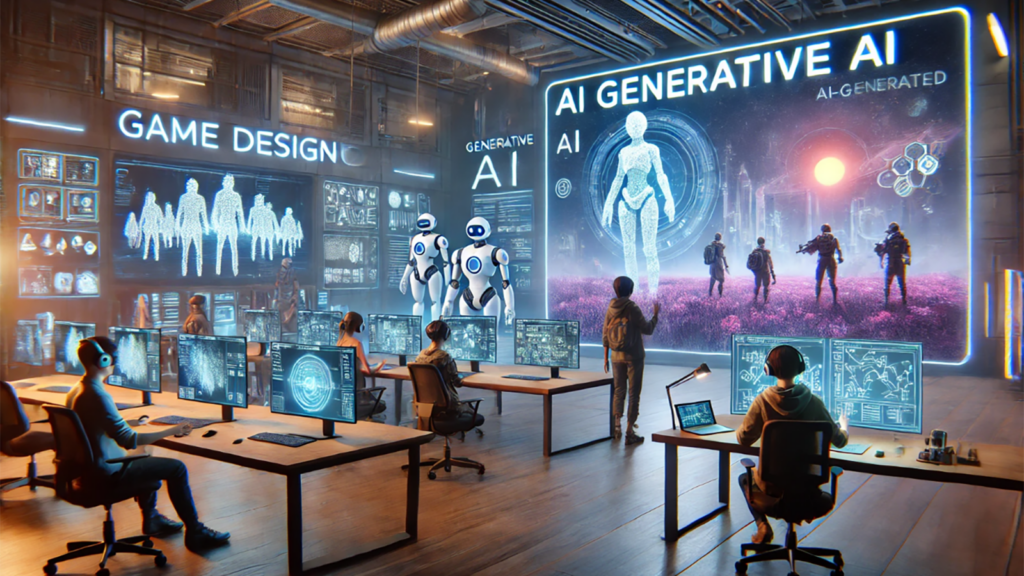
The gaming industry has always been at the forefront of technological innovation—pushing boundaries in graphics, interactivity, and immersion. Now, with the rise of Generative AI, game developers are entering a new era of creativity, efficiency, and personalized experiences. From building lifelike assets to crafting dynamic narratives, AI is reshaping how games are imagined, built, and played.
In this blog, we explore how generative AI is transforming asset creation and storytelling in the gaming world—unpacking tools, use cases, benefits, challenges, and the future of AI-driven game design.
What Is Generative AI?
Generative AI refers to algorithms that can generate new content—such as images, 3D models, music, voice, and text—based on data it has learned from. These models, like GPT-4, DALL·E, Midjourney, and Stable Diffusion, are capable of producing creative outputs that were once only achievable by human artists and writers.
In the context of gaming, this means:
- Creating game assets like textures, environments, and characters.
- Writing dialogue, quests, and entire story arcs.
- Generating voice lines, background music, and even code snippets.
AI-Generated Assets in Game Development
Asset creation is one of the most resource-intensive phases of game development. Artists, animators, and modelers spend countless hours designing visuals that bring a game world to life. With generative AI, much of this can be streamlined—or even automated.
1. 2D Concept Art and Textures
AI tools like DALL·E 3, Midjourney, and Stable Diffusion can generate concept art and textures from simple text prompts (e.g., “a medieval sword with glowing runes”). This accelerates prototyping and allows designers to explore a wide variety of styles and visual options.
2. 3D Model Generation
AI tools like Meshy, Kaedim, and Scenario can take 2D designs and convert them into low-poly or high-poly 3D models suitable for use in engines like Unity or Unreal Engine. This significantly cuts down modeling time and reduces bottlenecks in production.
3. Environment and World Design
Procedural generation has long been used for map generation (e.g., Minecraft or No Man’s Sky), but generative AI takes it further. AI models can now learn level design patterns and generate immersive environments, dungeons, or cityscapes that fit a specific aesthetic or gameplay loop.
4. Character Design and Animation
AI can help design characters with unique looks, costumes, and facial features. Some tools even generate walk cycles, facial expressions, and voice lines based on personality traits or emotional states.
Generative AI for Storytelling and Narrative Design
While assets provide the visuals, stories provide the soul of the game. Generative AI is enabling dynamic storytelling like never before—from AI-written quests to emotionally reactive NPCs.
1. Dynamic Dialogue Generation
AI can generate real-time dialogue based on player actions or choices. This replaces rigid branching dialogue trees with more fluid, responsive interactions.
Use Case: In a role-playing game, an NPC remembers a past encounter with the player and adjusts its tone, using GPT-based models to generate natural responses.
2. Procedural Quests and Story Arcs
Instead of manually scripting hundreds of side quests, developers can use AI to auto-generate missions based on world state, player level, or chosen faction.
Tool Example: Inworld AI, Latitude’s AI Dungeon
These quests can include:
- Unique objectives
- Custom dialogue
- Player-dependent outcomes
3. Character Backstories and Worldbuilding
AI can flesh out lore, histories, and cultural details for entire races or factions in a game universe—enhancing immersion and reducing manual writing.
Prompt Example: “Generate a cultural history for a subterranean elven society who worship time.”
4. Interactive Storytelling and AI Game Masters
In genres like text adventures or visual novels, AI can serve as an intelligent storyteller. This has birthed AI Dungeon, where players explore worlds with stories shaped in real-time by GPT models.
Trend: AI-powered Dungeon Masters in tabletop RPG games like D&D, creating custom campaigns on the fly.
Tools Empowering Generative AI in Games
| Tool | Use Case |
|---|---|
| Midjourney / DALL·E / Stable Diffusion | Concept art, environment textures |
| Scenario.gg | Game-specific asset generation, style-trained models |
| Kaedim / Meshy / Luma AI | 3D asset creation from sketches or prompts |
| Inworld AI / Charisma AI | Dynamic NPC dialogue and personality modeling |
| ElevenLabs / Replica Studios | Realistic voice generation |
| Latitude (AI Dungeon) | AI-powered interactive storytelling |
| Runway ML | Generative video and animation |
Benefits of Generative AI in Gaming
1. Faster Development Cycles
Developers can create and iterate on content more quickly, helping meet tighter deadlines and increasing agility.
2. Infinite Content Generation
AI allows for endless missions, characters, and items—extending game longevity without ballooning budget.
3. Empowering Small Teams
Indie developers gain access to production-level visuals and writing with fewer resources.
4. Personalized Experiences
Games can adapt to player style, choices, and preferences in real time, creating unique story arcs and character dynamics.
5. Cost Savings
Reducing the need for massive art and writing teams can lower development costs while maintaining high-quality output.
The Future of Generative AI in Gaming
Looking ahead, generative AI is poised to reshape not just game development, but how we experience games:
- AI Co-Developers: Real-time collaboration between human devs and AI during development.
- Player-Created Content: AI tools enabling players to create custom skins, levels, or dialogue.
- Living Worlds: Games that evolve based on player behavior, news, and real-world data.
- AI-Directed Games: Entirely AI-created games that blend assets, music, gameplay logic, and narrative.
The creative ceiling is lifting—and player agency is rising.
Generative AI is revolutionizing how games are made, experienced, and evolved. By taking over repetitive or resource-heavy tasks, AI gives developers more time to focus on vision, innovation, and fun. As we step into this new frontier, collaboration between humans and AI will be the engine behind the next wave of immersive, intelligent, and emotionally rich gaming worlds.
Whether you’re an indie dev, narrative designer, or AAA studio, one thing is clear: Generative AI is not just a tool—it’s a creative partner.